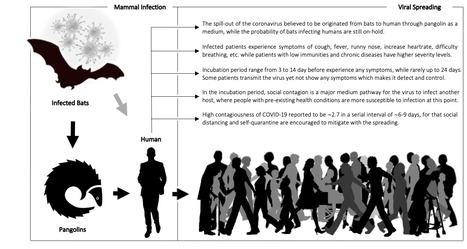Saad Alqithami
Computers 2021, 10(1), 12
Cases of a new emergent infectious disease caused by mutations in the coronavirus family, called “COVID-19,” have spiked recently, affecting millions of people, and this has been classified as a global pandemic due to the wide spread of the virus. Epidemiologically, humans are the targeted hosts of COVID-19, whereby indirect/direct transmission pathways are mitigated by social/spatial distancing. People naturally exist in dynamically cascading networks of social/spatial interactions. Their rational actions and interactions have huge uncertainties in regard to common social contagions with rapid network proliferations on a daily basis. Different parameters play big roles in minimizing such uncertainties by shaping the understanding of such contagions to include cultures, beliefs, norms, values, ethics, etc. Thus, this work is directed toward investigating and predicting the viral spread of the current wave of COVID-19 based on human socio-behavioral analyses in various community settings with unknown structural patterns. We examine the spreading and social contagions in unstructured networks by proposing a model that should be able to (1) reorganize and synthesize infected clusters of any networked agents, (2) clarify any noteworthy members of the population through a series of analyses of their behavioral and cognitive capabilities, (3) predict where the direction is heading with any possible outcomes, and (4) propose applicable intervention tactics that can be helpful in creating strategies to mitigate the spread. Such properties are essential in managing the rate of spread of viral infections. Furthermore, a novel spectra-based methodology that leverages configuration models as a reference network is proposed to quantify spreading in a given candidate network. We derive mathematical formulations to demonstrate the viral spread in the network structures.
Read the full article at: www.mdpi.com
Via Complexity Digest



 Your new post is loading...
Your new post is loading...








https://romiosupplystore.com/
https://romiosupplystore.com/shop/
https://romiosupplystore.com/product/buy-ativan-online/
https://romiosupplystore.com/product/buy-adderall-online/
https://romiosupplystore.com/product/buy-ambien-online/
https://romiosupplystore.com/product/buy-botox-online/
https://romiosupplystore.com/product/buy-codeine-online/
https://romiosupplystore.com/product/buy-demerol-online/
https://romiosupplystore.com/product/diapers/
https://romiosupplystore.com/product/buy-diazepam-online/
https://romiosupplystore.com/product/buy-efavirenz-online/
https://romiosupplystore.com/product/buy-emtricitabine-online/
https://romiosupplystore.com/product/buy-flakka-a-pvp-online/
https://romiosupplystore.com/product/buy-flakka-a-pvp-online/
https://romiosupplystore.com/product/buy-juvederm-volbella-le-online/
https://romiosupplystore.com/product/buy-juvederm-ultra-1ml-online/
https://romiosupplystore.com/product/buy-lortab-online/
https://romiosupplystore.com/product/buy-methadone-online/
https://romiosupplystore.com/product/buy-modafinil-online/
https://romiosupplystore.com/product/buy-morphine-sulfate-online/
https://romiosupplystore.com/product/buy-neurobloc-online/
https://romiosupplystore.com/product/buy-norco-online/
https://romiosupplystore.com/product/buy-opana-online/
https://romiosupplystore.com/product/buy-oxycodone-online/
https://romiosupplystore.com/product/buy-oxycontin-online/
https://romiosupplystore.com/product/buy-oxynorm-online/
https://romiosupplystore.com/product/buy-percocet-online/
https://romiosupplystore.com/product/buy-phentermine-online/
https://romiosupplystore.com/product/buy-fentanyl-patches-online/
https://romiosupplystore.com/product/buy-fentanyl-patches-online/
https://romiosupplystore.com/product/buy-lamivudine-online/
https://romiosupplystore.com/product/ritalin/
https://romiosupplystore.com/product/lidocaine/
https://romiosupplystore.com/product/buy-rheumacure-online/
https://romiosupplystore.com/product/buy-rohypnol-online/
https://romiosupplystore.com/product/buy-roxicodone-online/
https://romiosupplystore.com/product/buy-stilnox-online/
https://romiosupplystore.com/product/buy-suboxone-online/
https://romiosupplystore.com/product/buy-subutex-online/
https://romiosupplystore.com/product/buy-tenofovir-online/
https://romiosupplystore.com/product/buy-adipex-online/
https://romiosupplystore.com/product/buy-arimidex-online/
https://romiosupplystore.com/product/buy-dysport-online/
https://romiosupplystore.com/product/buy-vicodin-online/
https://romiosupplystore.com/product/buy-vyvanse-pills-online/
https://romiosupplystore.com/product/buy-xanax-online/
https://romiosupplystore.com/product/buy-xls-medical-max-strength-tablets-of-360/
https://romiosupplystore.com/product/buy-yellow-xanax-bars-online/
https://romiosupplystore.com/product/buy-zopiclone-online/
https://romiosupplystore.com/product/buy-zopiclone-online/
https://romiosupplystore.com/about/
https://romiosupplystore.com/contact/
https://romiosupplystore.com/product/buy-garcinia-cambogia-extract-online/
https://romiosupplystore.com/product/generic-finasteride/
https://romiosupplystore.com/product/buy-green-xanax-online/
https://romiosupplystore.com/product/buy-helex-online-in-usa/
https://romiosupplystore.com/product/buy-hydrocodone-online/
https://romiosupplystore.com/product/buy-klonopin-online/
https://romiosupplystore.com/product/buy-endocet-online/
https://romiosupplystore.com/product/buy-mobic-online/
https://romiosupplystore.com/product/buy-morphine-sulphate-injection/
https://romiosupplystore.com/product/buy-oxycodone-online/
https://romiosupplystore.com/product/buy-lamivudine-online/
http://romio.bloguetechno.com/Buy-Xanax-online-without-prescription-31452154
http://romio.bloguetechno.com/Buy-Yellow-Xanax-Bars-Online-31452538
http://romio1.bloguetechno.com/Buy-Klonopin-Online-31452928
http://romio1.bloguetechno.com/Buy-Ativan-Online-31453213
http://romio1.bloguetechno.com/-Buy-adderall-online-at-romiosupplystore-with-or-without-prescription-31453339
http://romio1.bloguetechno.com/BUY-ALIAXIN-GP-1ML-ONLINE-31453497
http://romio3.bloguetechno.com/Buy-Ambien-online-31454947
http://romio3.bloguetechno.com/buy-botox-online-without-license-Allergan-Botox-1x100iu--31455120
http://romio3.bloguetechno.com/Buy-CBD-Oil-Grade-Hemp-Extract--31455260
http://romio3.bloguetechno.com/Buy-Codeine-Online-without-Prescription--31455396
http://romio4.bloguetechno.com/Buy-Demerol-Online-31463368
http://romio4.bloguetechno.com/Buy-Diamorphine-online-At-31463473
http://romio4.bloguetechno.com/Buy-Diazepam-Online-31463607
http://romio4.bloguetechno.com/Buy-Dilaudid-Online-31463689
http://romio4.bloguetechno.com/Buy-efavirenz-online-31463787
http://romio4.bloguetechno.com/Buy-Emtricitabine-At-a-Discount-31463944
http://romio4.bloguetechno.com/Buy-Endocet-Online-31464084
http://romio5.bloguetechno.com/Buy-Flakka-A-pvp-31464222
http://romio5.bloguetechno.com/Buy-Garcinia-Cambogia-Extract--31464351
http://romio5.bloguetechno.com/Buy-Generic-Finasteride-Online-31464482
http://romio5.bloguetechno.com/Buy-Green-Xanax-Online-From-the-best-online-pharmacy-31464625
http://romio6.bloguetechno.com/Buy-Helex-online-31505573
http://romio7.bloguetechno.com/Buy-Lortab-Online-Without-Prescription-31585080
http://romio7.bloguetechno.com/Buy-Methadone-Online-31585239
http://romio7.bloguetechno.com/Buy-Mobic-Online-Cheaper-31585364
http://romio7.bloguetechno.com/Buy-Modafinil-Online-Cheapper-31585530
http://romio7.bloguetechno.com/Buy-Morphine-Online-Without-Prescription-31585601
http://romio7.bloguetechno.com/Buy-Morphine-sulphate-Injection-online-31585699
http://romio8.bloguetechno.com/Buy-NeuroBloc-Online-31585855
http://romio8.bloguetechno.com/Buy-Norco-Online-Norco-10-325-Buy-Online-31585931
http://romio8.bloguetechno.com/Buy-Opana-Online-31586048
http://romio8.bloguetechno.com/Buy-Oxycodone-Online-without-prescription-31586151
http://romio8.bloguetechno.com/Buy-Oxycontin-Online-Cheap-Without-Prescription-31587189
http://romio8.bloguetechno.com/Buy-OxyNorm-Online--31587808
http://romio9.bloguetechno.com/Buy-Percocet-online-31588283
http://romio9.bloguetechno.com/Buy-phentermine-online-31588401
http://romio9.bloguetechno.com/Buy-Quality-Fentanyl-Patches-Online-31588563
http://romio10.bloguetechno.com/Buy-Quality-lamivudine-online-31588786
http://romio10.bloguetechno.com/Buy-Quality-Ritalin-Online-Without-Prescription-31588868
http://romio10.bloguetechno.com/BUY-RESTYLANE-LIDOCAINE-with-or-without-prescription-31589004
http://romio10.bloguetechno.com/buy-RHEUMACURE-online-31589114
http://romio11.bloguetechno.com/Buy-Rohypnol-online-31589253
http://romio11.bloguetechno.com/Buy-Roxicodone-Online--31589309
http://romio11.bloguetechno.com/Chemistry-of-Stilnox-31589382
http://romio11.bloguetechno.com/Buy-Suboxone-Online-31589453
http://romio11.bloguetechno.com/Buy-Subutex-Online-31589522
http://romio12.bloguetechno.com/Buy-tenofovir-online-31609358
http://romio12.bloguetechno.com/Buy-Adipex-online-china-31609548
http://romio12.bloguetechno.com/Buy-Arimidex-Online-without-prescription-31609642
http://romio12.bloguetechno.com/Buy-Dysport-Online--31609718
http://romio12.bloguetechno.com/Buy-Vicodin-Online-31609779
http://romio12.bloguetechno.com/Buy-Vyvanse-Online-31609844
http://romio13.bloguetechno.com/Buy-Xanax-Online-without-prescription-31609982
http://romio13.bloguetechno.com/Buy-XLS-Medical-Max-Strength-Tablets-Online-31610098
http://romio13.bloguetechno.com/Buy-Yellow-Xanax-Bars-Online-31610210
http://romio13.bloguetechno.com/Buy-Zopiclone-Online-Without-Prescription-31610285
http://romio13.bloguetechno.com/Buy-Greenstone-Xanax--31610350
https://cuteteacuppups.com/available-pups/
https://cuteteacuppups.com/product/buy-beautiful-pomeranian-princess-610/
https://cuteteacuppups.com/product/buy-chihuahua-puppy-taky-700/
https://cuteteacuppups.com/product/buy-chihuahua-puppy-taky-700/
https://cuteteacuppups.com/product/buy-maltese-puppy-kelly/
https://cuteteacuppups.com/product/buy-maltese-puppy-max/
https://cuteteacuppups.com/product/buy-pomeranian-puppy-kane/
https://cuteteacuppups.com/product/buy-poodle-puppy-leo-680/
https://cuteteacuppups.com/product/buy-poodle-puppy-lili/
https://cuteteacuppups.com/product/yorkshire-puppy-henry/